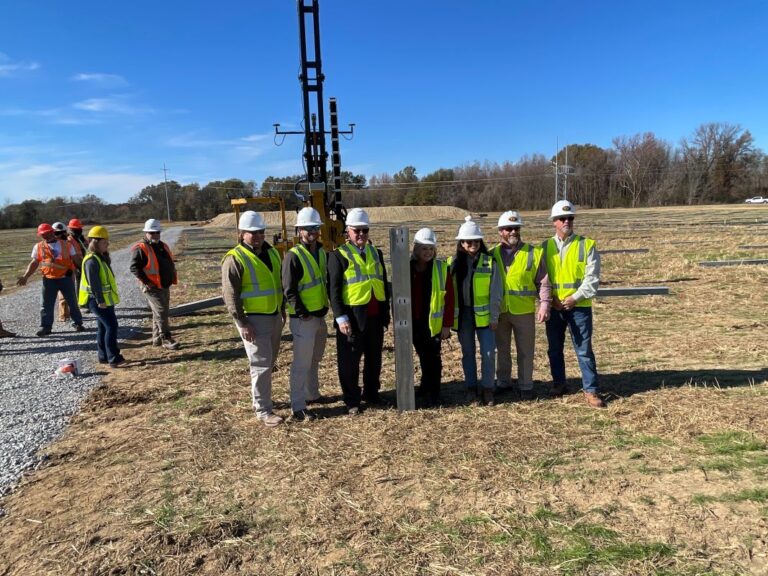Residents of Panola County, Mississippi, are saying yes to solar energy. Clearloopa subsidiary of Silicon Ranch, has worked closely with the community to develop a series of large-scale projects that deliver mutual benefits to the company, its customers and the surrounding region.
Panola County is a community at the cross-section of the Mississippi Delta and the Appalachian Foothills, and these projects will be the first solar projects for the area.
Clearloop broke down the first of three projects in Panola County last April and followed that up in August with the announcement that Microsoft would be an anchor customer for the second project. The third solar energy project kicks off a multi-year collaboration between Vanderbilt University and Clearloop.
Combined, the projects will generate 18 MW and are developed in collaboration with the Tallahatchie Valley Electric Power Association (TVEPA) and with the support of the local economic development group, the Panola Partnership. TVEPA partners with Clearloop and its parent company, Silicon Ranchto bring locally generated, reliable renewable energy to the province for the first time.
Quick snapshot of the three Panola projects:
- Panola I Solar Farm is a 6.6 MWdc project backed by Vista Equity Partners and 21 of their portfolio companies in the United States, as well as Uber, Oak View Group/GOAL, Infoblox, FarmHouse Fresh, Chicory Wealth, Goodr, Patch, Grandma Mae’s Country Naturals, Aether Diamonds, Rivian and Material Bank. Delivery is expected in the summer of 2024.
- Panola II Solar Farm is also a 6.6 MWdc project supported by Microsoft. Building permits were granted in November and construction is expected to be completed in summer 2024.
- Panola III Solar Farm is a 4.8 MWdc project supported by Vanderbilt University. The project is expected to be completed in the autumn of 2024.
Clearloop plans to host a ‘flip the switch’ event for Panola I and II in June.
Build support
A primary factor in the success of these projects has been the relationships Clearloop has built in Panola County. CEO and co-founder Laura Zapata credits the company’s early efforts to establish communications with leaders in the region.
“The biggest thing we were trying to figure out early on, because this project was the first solar project in this community, was providing education for what we’re trying to accomplish,” Zapata said last fall. “About two years ago, we reached out to economic development leaders. We worked with Panola County to resolve any issues, and we were able to do that because we had such a strong relationship with the people there. Everything from our introduction to the local energy company to identifying landowners interested in selling land, it was important to us to know what was happening in the community, and we couldn’t have done that if we didn’t have boots on had the land to do that. early.”
Zapata praises the strong support Clearloop has received from the community.
“This is an exciting case where people said, ‘Yes, in my backyard.’ They immediately embraced the idea,” she said. “Part of that support comes from Silicon Ranch’s commitment to being a long-standing operating partner in the area and long-term neighbors. Hopefully that will lead to more opportunities.”
Clearloop worked with the community to ensure the project looked beautiful from the passing highway.
“They wanted it nicely fenced in,” Zapata said. “It’s like a welcome mat to the community. It was a different request, but it shows the collaboration we had and offers more opportunities to get more people interested in solar energy.”
Zapata described Panola County as an underserved community when it comes to solar energy, and expanding equitable access to clean energy is one of the driving forces behind the three projects. She pointed to Microsoft’s investment to highlight the appeal of solar projects for larger companies aiming to decarbonize their operations.
“If we want to decarbonize at scale, we need more of the country to see itself reflected in our efforts,” she said. “Microsoft has climate dollars to spend. Their investment helps improve communities where Microsoft may not be active, but now it has reasons to be connected to those communities because they have investments there.”
Overcoming NIMBYism
Zapata discussed the opposition facing some large-scale solar projects in the United States and what is driving these efforts.
“There is increasing misinformation, but also a trust gap, where some people may have said they wanted to invest in a community but they didn’t follow through,” she said. “We as an industry need to work with communities. How does solar energy work? We need light, not heat. Fundamental things like that, to go back to basics and build trust through very simple assistance and information. The good news is that there are success cases we can point to.”
Although solar technology has been around for decades, the massive expansion of large-scale projects is new for many areas.
“We have a great opportunity in the solar industry in general to do more outreach,” Zapata said. “My idea is that if you want to use a friend, you have to make one first. We need to contact people in advance to say this is what we’re going to do. There is a great opportunity for education because solar energy is new in many areas and can be politicized in terms of what its implications are for the climate and the economy. If we’re going to invest in places that haven’t had solar before, I think we need to talk less about the big scary climate change, and more about the economic opportunities of solar.”
Zapata highlighted some topics developers can discuss when working with communities.
“What does the project actually do? How do we land? How do we take care of the solar systems? There is a big movement happening through land management practices to rejuvenate land,” she said. “Projects also create jobs in construction, as well as opportunities for new careers in O&M and all kinds of work in the electrical sector. If we do it right, there is a pipeline for new careers for young people in the solar energy sector. There are opportunities for all kinds of developers where we can make a difference in these communities.”
Maintaining the relationship
As is the case with all Clearloop projects, the Panola Solar Farms will be developed, owned and operated by Silicon Ranch for the life of the project. Clearloop will maintain a vested interest in Panola County and the surrounding region over the long term.
“We have continued to strengthen our relationship and support with Panola County,” Zapata said. “Last November, we hosted local leaders and neighbors as they broke ground on the first of three solar projects in their communities.”
Present at the event were Brad Robison, CEO of TVEPA; Kerry Davis, TVEPA chief engineer; Joe Azar, executive director of the Panola Partnership (economic development); Robbie Haley, Director of Human Resources, Panola Partnership; Cyndy Butler, TVEPA; Mississippi State Senator Nicole Boyd; Batesville, Mississippi, Mayor Hal Ferrell; Panola County Board Chairman Cole Flint; and leaders of the West Camp MB Church
“Panola County, Mississippi, is a true ‘Yes, in my backyard’ solar community,” said Zapata, “and we hope this will be the model for many more communities to welcome the investment in their community and want to be seen. as innovators.”
Listen to more in-depth conversations on Solar Builder’s YouTube channel

Our most popular series include:
Power forward! | A collaboration with BayWa re to discuss industrial topics at a higher level.
The buzz | Where we give our 2 cents per kWh in the residential solar market.
The pitch | Discussions with solar manufacturers about their new technology and ideas.
Source link


